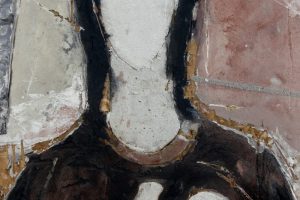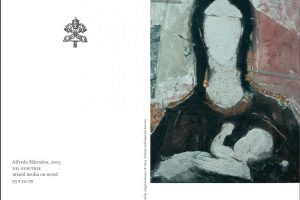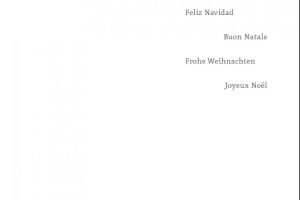
‘DEI GENITRIX’, A CONTEMPORARY IMAGE FOR THE VATICAN
December 2005
For the first time in History, the Vatican launches itself into the world of contemporary art by choosing the artwork of a current artist. The Vatican Information Service (V.I.S.) orders Bikondoa the image for the limited edition of his Christmas greeting with which the Vatican will congratulate Christmas 2005.
The Christmas greeting, by Miguel Chavarría (article published in Diario Vasco in 12/26/2005)
Just a few days ago, a Christmas greetings card from the Vatican came to my house. It was the representation of the Virgin and Child, a clearly modern artwork in contrast to the antiquity attributable to a millennial institution. However, receiving a greetings card is nothing more than a small event not especially remarkable in this Advent season (…)
Nothing strange, there is to receive such greetings card on the dates we are. But, I repeat, this is not just any greetings card. It comes from Rome and comes from the Vatican. More specifically its Press Service. And the Vatican, apart from other important considerations, has preserved artistic collections that are among the most important and illustrious on Earth. Its large rooms, museums and lodges, full of works of art, are true miracles of good taste and of correct criteria of conservation and patronage sustained throughout the centuries.
The Christmas greeting, in the form of a diptych, represents a Madonna, the work of Alfredo Bikondoa, a basque artist who does not seem interested in liking or pleasing, but touching the heart. He himself has clarified what he considers to be the heart: “not the affective, but the one who is related to the All, the Alpha and the Omega, the Core and the Matrix, the Origin and the Final” I have been fortunate to know the original, very recent work, and already in the hands of a collector of great sensitivity.
The Madonna of Bikondoa is a true masterpiece of classic taste for its strength, its expressive sobriety and its exemplary balance.
It is a modern work, for its bold approach that, without leaving the field of painting, places it in the vicinity of the sculptural bas-relief.
It is a work unmistakably today because of the wide and comfortable freedom with which the author makes use of the most diverse techniques applied on dissimilar materials such as wood, lead, resins and marble sand.
It is, in short, a work of theological depth that shows, alive and sweetly, the connection between the motherhood of Mary and the Redemption, present in that Cross, still without crucified, which rises, like a labarum of Freedom, to the right Of the figure of the Mother of God.
How to frame this work of Bikondoa? But if this artist goes for free! This artist has not fallen, like so many, in the collapse of the clichés dividing between the abstract and the figurative. This artist has not been caught between the rigid alignments of that specific Mannerism that is born of the classifications raised as dogmas and obeyed as mandates.
Are we facing an image of worship? Is this an image of devotion? We are above all this, and more, in some way, because it is an image of contemplation, of personal contemplation of who has wanted to dive in the Mystery and has managed to express it with efficiency and tenderness by leaning on the confident inner attitude of the person who, for Not to have squandered in senseless salvos the bitter questions he came to the world, he knows how to open the windows of his heart to the ineffable and takes responsibility for what he finds.
What can a Virgin Mother without a face suggest? Mary without a face? No. But Mary, without factions, so that all the mothers of the earth may offer theirs, and each individual be able to identify the gesture of Hope and the giving of the Love of God to the men of this world, which the Eternal Father, When he finished doing it, he considered it good, according to Genesis.
I note at the end: the entity that sends the card belongs to a millennial institution that has sponsored and kept intact an important part of the most illustrious artistic historical heritage of mankind; But this year – for the first time in history – a modern work has been chosen to graphically complete the expression of their congratulations on the occasion of the Nativity. There are, then, a thousand high motives to rejoice.



